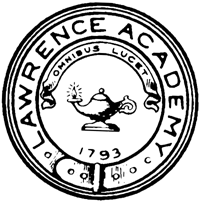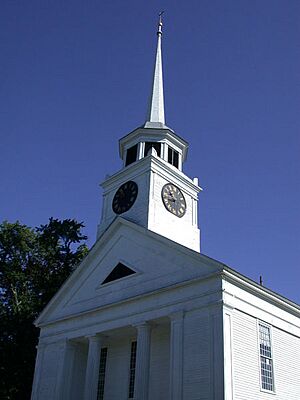Lawrence Academy (Groton, Massachusetts) facts for kids
Quick facts for kids Lawrence Academy |
|
|---|---|
 |
|
| Address | |
|
26 Powderhouse Road
, 01450
|
|
| Coordinates | 42°36′14″N 71°33′58″W / 42.60389°N 71.56611°W |
| Information | |
| Motto | Omnibus lucet (Let light shine upon all) |
| Established | 1793 |
| Head of School | Dan Scheibe |
| Faculty | ~80 |
| Enrollment | 400 |
| Campus type | Exurban |
| Color(s) | Red and Blue |
| Nickname | Spartans |
| Rivals | Tabor Academy, Groton School (Unofficial) |
Lawrence Academy at Groton is a private school in Groton, Massachusetts. It's a boarding school, meaning some students live there. It's for both boys and girls and helps them get ready for college. The school isn't connected to any specific religion.
It was started in 1792 as Groton Academy. Governor John Hancock officially approved it in 1793. Lawrence Academy is one of the oldest boarding schools in the United States. It's the third oldest in Massachusetts.
Many famous people have gone to Lawrence Academy. These include Harvard University president James Walker and America Online CEO Tim Armstrong. Founders of important universities like Gallaudet University also studied here.
Contents
History of Lawrence Academy
How the School Started
On April 27, 1792, about 50 people from Groton and Pepperell decided to create a "Publick School." They wanted to educate young people, both boys and girls. The school would teach subjects like English, math, geography, and languages such as Latin and Greek. Important citizens like Oliver Prescott helped start Groton Academy. Samuel Lawrence also gave money, beginning a long connection with the Lawrence family.
The school officially received its charter in 1793. In 1797, the state gave it land in Maine to help pay for things. The main goal was to educate students from the local area. Groton was a big town back then. Even though some students came from far away, the school focused on local students.
In the early days, not many students went to college. Teachers often stayed for only a year or two. Still, Groton Academy became well-known. Between 1801 and 1870, about 50 students went on to Harvard College. This made it one of Harvard's top feeder schools. Many notable people taught at the academy. These included Asahel Stearns, who helped start Harvard Law School.
Early graduates included James Walker, who became president of Harvard University. John Prescott Bigelow became mayor of Boston. Robert H. Terrell was the first Black graduate of Lawrence Academy in 1879. He later became the first Black federal judge.
The Lawrence Family's Support
On February 28, 1846, Groton Academy changed its name to Lawrence Academy at Groton. This was to honor the Lawrence family. All eight children of Samuel Lawrence had attended the school.
In 1838, brothers Amos and William Lawrence started giving money to the academy. They were rich merchants from Boston. Amos first gave books and science equipment. Later, he gave a telescope and $2,000 to make the schoolhouse bigger. In 1844, William gave $10,000 to help the school forever. By 1850, Amos had given most of the books in the school's library.
Over their lives, Amos and William Lawrence gave nearly $65,000 to the school. This included money, scholarships, and property. This amount would be about $2.6 million today. Their brothers, Luther and Samuel, also served on the school's board.
The Lawrence family's money also helped the academy connect with other colleges. They set up 12 scholarships for Lawrence Academy graduates. These scholarships helped students attend Williams College, Bowdoin College, and Wabash College.
Changes and Modern Times
In the mid-1800s, the school faced challenges due to religious disagreements in Groton. The town tried to make Lawrence Academy a public high school, but the school's leaders said no. In 1860, Groton opened its own public high school, Groton High School. This gave students another choice. Also, in 1884, the Lawrence family helped start Groton School, another private school.
In 1899, Lawrence Academy changed to become a traditional college-prep boarding school. It raised its tuition and focused on preparing students for college entrance exams. It stopped admitting girls for a time. The school also started to focus more on students who lived at the school.
The academy had some tough times financially. It closed twice. The first time was from 1869 to 1871 after its schoolhouse burned down. It cost a lot to rebuild. It closed again from 1898 to 1899 while it changed to an all-boys school. The school became financially strong again in the 1940s. However, the campus burned down again in 1956.
Lawrence Academy started admitting both boys and girls again in 1971. Better fundraising in the 1980s and 1990s helped the school's finances a lot.
Today, many students at Lawrence Academy are from the local area. Many international students also attend. About 58% of students are day students, meaning they don't live at the school. About a quarter of the boarding students come from other countries. In the 2021–22 school year, 424 students were enrolled.
Athletics
Lawrence Academy's sports teams play in the Independent School League. Many great athletes have come from the academy.
Ice Hockey
- Laurie Baker, 1998 Olympic gold medalist
- Jim Campbell
- Greg Crozier, two-time NCAA champion
- Doug Friedman
- Steve Heinze, played on the 1992 U.S. Olympic team
- Vic Heyliger, head coach at the University of Michigan; six-time NCAA champion
- David Jensen, played on the 1984 U.S. Olympic team
- Rand Pecknold, head coach at Quinnipiac University; NCAA champion in 2023
- Jeff Serowik
- Sam Colangelo, current forward for the Anaheim Ducks
Basketball
- Shabazz Napier, two-time NCAA champion
- Richard Roby
- Antoine Wright
Other Sports
- Jonah Bayliss (baseball)
- Tyler Beede (baseball)
- Guillermo Cantú (soccer)
- A. J. Dillon (football)
- Cynthia Ryder (rowing)
Notable Alumni
- Tim Armstrong — class of 1989, former CEO of AOL
- William Bancroft — first president of the Boston Elevated Railway, politician
- Charles Beecher — minister, hymn composer, and author
- Henry Adams Bullard — U.S. Representative from Louisiana
- Richard Burgin — author, editor of Boulevard magazine
- Karyn Bryant — television personality; MTV VJ, CNN anchor
- Bruce Crane — president and chairman of Crane & Co., politician
- James Dana — fifth mayor of Charlestown, Massachusetts
- Rhoda A. Esmond - helper of others, leader in the temperance movement
- Eric Gaskins — fashion designer
- Samuel Abbott Green — doctor, librarian, historian, and 28th Mayor of Boston
- Donald L. Harlow — Chief Master Sergeant of the Air Force
- Edward D. Hayden — U.S. Representative from Massachusetts
- Frederick "Moose" Heyliger — World War II paratrooper featured in Band of Brothers
- Chase Hoyt — film, television, and stage actor
- Amos Kendall — eighth Postmaster General (head of the mail service) and founder of Gallaudet College for the deaf
- Abbott Lawrence — Member of Congress, Minister to Great Britain, founder of Harvard University's Division of Engineering and Applied Sciences
- Amos Adams Lawrence — abolitionist, politician, founder of the University of Kansas and Lawrence University
- Amos Lawrence — industrialist; helper of others
- Charles H. Mansur — member of the U.S. House of Representatives from Missouri
- Cat Marnell — writer
- Julie Mason — newspaper and radio journalist
- Page McConnell — Phish musician
- Albert E. Pillsbury — President of the Massachusetts State Senate and Massachusetts Attorney General
- William Adams Richardson — 29th Secretary of the Treasury and Chief Justice of the United States Court of Claims
- Maria Rodale — publisher; chairman and CEO of Rodale, Inc.
- Ether Shepley — politician; Senator from Maine, Chief Justice of the Maine Supreme Judicial Court
- Jim Sokolove — television attorney
- Huntley N. Spaulding — helper of others; Governor of New Hampshire
- Charles Warren Stone — politician; Congressman and Lieutenant Governor from Pennsylvania
- Frank Bigelow Tarbell — historian, archeologist and professor at University of Chicago
- George Makepeace Towle — lawyer, politician, and author
- Dr. James Walker — minister and 21st president of Harvard University
- William B. Washburn — Governor of Massachusetts, U.S. Representative, U.S. Senator
- William Channing Whitney — architect
- William Allan Wilde — publisher; politician
Notable Faculty
- Samuel Adams Holyoke — first headmaster
- Robert V. Bruce — 1988 winner of the Pulitzer Prize for History
- Brian Feigenbaum — founder of Food Not Bombs


